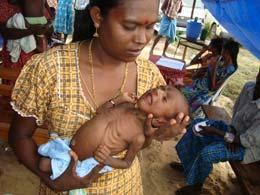India’s national shame

India constitutes 40 percent of the world’s malnourished population and the highest rate of underweight children due to improper implementation of government policies, a global health expert has said.
M G Venkatesh Mannar, president of Canada-based NGO Micronutrient Initiative, said India’s condition despite being an emerging economy was bad in terms of health and nutrition as compared to other countries like Brazil, Nepal, Bangladesh and China.
“India has the highest rates of stunted growth, underweight and anaemia in children. And the most ironic part is that India has all the programs and policies required to handle the problem but then there is no proper implementation.
“In India, a country with one of the world´s largest workforces, nutrition is a critical issue that has tremendous implications on the next generation to fulfil its physical and intellectual potential and continue to drive India´s progress on the global stage,” said Mannar.
“In my time in India, I have witnessed first-hand the consequences for a child that result from early malnutrition. The opportunities to invest in nutrition are known. Without the right investments, India risks squandering its massive potential.”
“Here it cuts across many ministries like the Ministry of Health, Women and Child Development, Education and Rural Development. Thus there are no champions of this problem and also no proper accountability,” Mannar, who is one of the co-authors of the 2013 Lancet series on Maternal and Child Undernutrition.
The Lancet Series outlines the consequences that result from early malnutrition, as well as the opportunities that an investment in nutrition presents. Eliminating undernutrition in young children not only saves lives and ensures a child can grow to their fullest potential but it can boost GNP of countries like India by up to 11%.
The Series highlighted the staggering contribution of poor nutrition to mortality: almost half of all child deaths in the world today are the result of poor nutrition, including approximately 745,000 in India alone each year.
Mannar and others called on the Government of India to give more attention to malnutrition, specifically by confronting and quantifying the problem through routine national and sub-national surveillance data collection, and to use the data to effectively target and monitor progress moving forward. They also urged better coordination between state and central governments and the public, private and civic society sectors.
“If the children of India aren´t able to survive, fully grow and develop, neither is this great nation,” Mannar said. “This is about more than feeding people today—it is about nourishing tomorrow´s leaders and India´s future. Let´s not wait for political will, let´s will our politicians to act.”
There is a lack of coordination between the state and Centre because of which there is a problem of implementation of the policies and programmes made in this regard, Mannar, who was also honoured with Canada’s highest civilian award ‘The Order of Canada’, said.
“The astonishing part is that National Family Health Survey has not been done since 2005. We still look at the old figures and we are not aware whether we have progressed or regressed,” he said.
He, however, praised some states like Maharashtra for achieving their targets. “If Maharashtra can do it, why other states can’t?” he asked.
Appealing to the government to take action, he said India does not have to look outside for any help as it has all the policies and resources required to solve the problem.
“India just needs to get into action otherwise there will be severe consequences. What would all that economic growth mean if the new generation turns unproductive and perform below the world standards?” he asked.
According to World’s Children Report 2013 prepared by the UNICEF, India ranks 49th in the Under 5 Mortality rate whereas China, Brazil, Nepal and Bangladesh stand at 115, 107, 57 and 60 respectively.
The neo-natal mortality rate 2011 of India is 32 per 1,000 live births whereas it is 10 per 1,000 live births in Brazil and 26 per 1,000 live births in Bangladesh. India’s infant mortality rate has reduced from 81 per 1,000 lives to 47 per 1,000 between 1990 and 2011 whereas it has reduced from 49 to 14 per 1,000 lives in Brazil during the same period.
Recent data show that the growth and development of nearly half of the children in India are stunted due to poor nutrition. Undernutrition accounts for 45% of the approximately 1.65 million child deaths every year, leads to irreversible consequences for those that survive, and has enormous costs in terms of health, wellbeing and the economic development of a country.
Leave a comment









